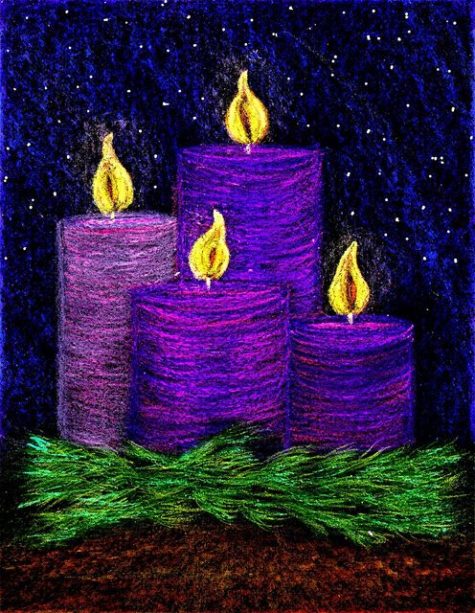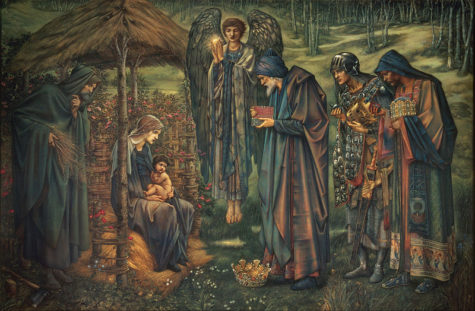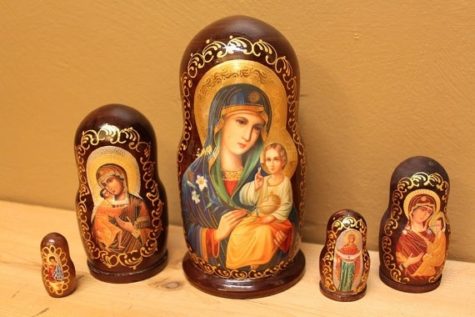Daily Archives: December 3, 2015
Advent is a season observed in many Western Christian churches as a time of expectant waiting and preparation for the celebration of the Nativity of Jesus at Christmas. The term is a version of the Latin word meaning “coming”.
It is unknown when the period of preparation for Christmas that is now called Advent first began – it was certainly in existence from about 480 – and the novelty introduced by the Council of Tours of 567 was to order monks to fast every day in the month of December until Christmas. Some have even said it goes back to the time of the Twelve Apostles or that it was founded by Saint Peter himself. This has led to the conclusion that it is “impossible to claim with confidence a credible explanation of the origin of Advent”.
For Christians, the season of Advent anticipates the coming of Christ from three different perspectives. “Since the time of Bernard of Clairvaux (d.1153) Christians have spoken of the three comings of Christ: in the flesh in Bethlehem, in our hearts daily, and in glory at the end of time.” The season offers the opportunity to share in the ancient longing for the coming of the Messiah, and to be alert for his Second Coming.
Advent is the beginning of the Western liturgical year and commences on the fourth Sunday before Christmas, the Sunday nearest to St. Andrew’s Day (30 November), in the Roman Rite of the Catholic Church, and in the Anglican, Lutheran, Moravian, Presbyterian and Methodist calendars. In the Ambrosian Rite and the Mozarabic Rite of the Catholic Church, Advent begins on the sixth Sunday before Christmas, the Sunday after St. Martin’s Day (Nov 11).
Practices associated with Advent include keeping an Advent calendar, lighting an Advent wreath, praying an Advent daily devotional, as well as other ways of preparing for Christmas, such as setting up Christmas decorations, a custom that is sometimes done liturgically, through a hanging of the greens ceremony.
The equivalent of Advent in Eastern Christianity is called the Nativity Fast, but it differs in length and observances, and does not begin the liturgical church year as it does in the West. The Eastern Nativity Fast does not use the equivalent parousia in its preparatory services.
Folk traditions:
In England, especially in the northern counties, there was a custom (now extinct) for poor women to carry around the “Advent Images”, two dolls dressed to represent Jesus and the Blessed Virgin Mary. A halfpenny coin was expected from every one to whom these were exhibited and bad luck was thought to menace the household not visited by the doll-bearers before Christmas Eve at the latest.
In Normandy, farmers employed children under twelve to run through the fields and orchards armed with torches, setting fire to bundles of straw, and thus it was believed driving out such vermin as were likely to damage the crops.
In Italy, among other Advent celebrations is the entry into Rome in the last days of Advent of the Calabrian pifferari, or bagpipe players, who play before the shrines of Mary, the mother of Jesus: in Italian tradition, the shepherds played these pipes when they came to the manger at Bethlehem to pay homage to the infant Jesus.
In recent times the most common observance of Advent outside church circles has been the keeping of an advent calendar or advent candle, with one door being opened in the calendar, or one section of the candle being burned, on each day in December leading up to Christmas Eve. In many countries, the first day of Advent often heralds the start of the Christmas season, with many people opting to erect their Christmas trees and Christmas decorations on or immediately before Advent Sunday.
Colors of Advent:
The usual liturgical color in Western Christianity for Advent is either violet (or purple) or blue. The violet or purple color is often used for hangings around the church, the vestments of the clergy, and often also the tabernacle. In some Christian denominations, blue, a color representing hope, is an alternative liturgical color for Advent, a custom traced to the usage of the Church of Sweden (Lutheran) and the medieval Sarum Rite in England.
The Lutheran Book of Worship lists blue as the preferred color for Advent while the Methodist Book of Worship and the Presbyterian Book of Common Worship identify purple or blue as appropriate for Advent. There has been an increasing trend in Protestant churches to supplant purple with blue.
Proponents of this new liturgical trend argue that purple is traditionally associated with solemnity and somberness, which is fitting to the repentant character of Lent. The Roman Catholic Church retains the traditional violet.
On the 3rd Sunday of Advent, Gaudete Sunday, rose may be used instead, referencing the rose used on Laetare Sunday, the 4th Sunday of Lent. During the Nativity Fast, red is used by Eastern Christianity, although gold is an alternative color.
 Four Sundays and Four Candles:
Four Sundays and Four Candles:
The keeping of an advent wreath is also a common practice in homes or churches. The readings for the first Sunday in Advent relate to the old testament patriarchs who were Christ’s ancestors, so some call the first advent candle that of hope.
The readings for the second Sunday concern Christ’s birth in a manger and other prophecies, so the candle may be called of Bethlehem, the way or of the prophets.
The third Sunday, Gaudete Sunday after the first word of the introit (Philippians 4:4), is celebrated with rose-colored vestments similar to Laetare Sunday at the middle point of Lent. The readings relate to St. John the Baptist, and the rose candle may be called of joy or of the shepherds.
In the Episcopal Church USA, the collect stir up may be read during this week, although before the 1979 revision of the Book of Common Prayer it was sometimes read in the first Sunday of Advent. Even earlier, ‘Stir-up Sunday’ was once jocularly associated with the stirring of the Christmas mincement, begun before Advent. The phrase ‘Stir up’ occurs at the start of the collect for the last Sunday before Advent in the 1662 Book of Common Prayer.
The readings for the fourth Sunday relate to the annunciation of Christ’s birth, so the candle may be known as the Angel’s candle. The Magnificat or Song of Mary may be featured.
Where an advent wreath includes a fifth candle, it is known as the Christ candle and lit during the Christmas Eve service.
Source: Wikipedia





